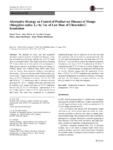Por favor, use este identificador para citar o enlazar este ítem:
http://www.alice.cnptia.embrapa.br/alice/handle/doc/1017693Registro completo de metadatos
| Campo DC | Valor | Lengua/Idioma |
|---|---|---|
| dc.contributor.author | TERAO, D. | pt_BR |
| dc.contributor.author | CAMPOS, J. S. de C. | pt_BR |
| dc.contributor.author | BENATO, E. A. | pt_BR |
| dc.contributor.author | HASHIMOTO, J. M. | pt_BR |
| dc.date.accessioned | 2015-06-15T11:11:11Z | pt_BR |
| dc.date.available | 2015-06-15T11:11:11Z | pt_BR |
| dc.date.created | 2015-06-15 | pt_BR |
| dc.date.issued | 2015 | pt_BR |
| dc.identifier.citation | Food Engineering Reviews, New York, v. 7, n. 2, p. 171-175, June 2015. | pt_BR |
| dc.identifier.issn | 1866-7910 | pt_BR |
| dc.identifier.uri | http://www.alice.cnptia.embrapa.br/alice/handle/doc/1017693 | pt_BR |
| dc.description | The demand for clean, safe and sustainable alternative control measures of postharvest diseases of fruit has increased in recent years, and the use of UV-C irradiation is a potential option. This study focused on evaluating UV-C dose effect on in vitro and in vivo development of fungi species and also on postharvest decay on mango cv. Tommy Atkins. The evaluated fungi which cause decay were as follows: Botryosphaeria dothidea, Lasiodiplodia theobromae, Alternaria alternata and Colletotrichum gloeosporioides. Fungus mycelium was exposed to increasing doses of UV-C irradiation: 0 (control), 2.0, 3.0, 5.0, 10.0 and 20 kJ m-2. L. theobromae and A. alternata received dose up to 59.7 kJ m-2. Mangos artificially inoculated with B. dothidea were treated with doses of UV-C irradiation: 0.0, 0.5, 1.0, 2.5, 5.0, 7.5 e 10.0 kJ m-2 and stored at 10 °C for 15 days and for 2 days at 22 °C, observing the rot on daily basis. The trials were conducted in a completely randomized design with six replicates for in vitro tests and four replicates with seven fruit as experimental unit. The in vitro trials demonstrated that even high dose of UV-C (20 kJ m-2) was not able to control the fungi development. Nonetheless, low dose of UV-C irradiation at 2.5 kJ m-2 controlled around 70 % of fruit rot severity. Higher doses ([5 kJ m-2) caused damage on mango peel increasing the rot severity. Results suggest that, the application of low dose (\3 kJ m-2) of UV-C irradiation can contribute to the integrated management of postharvest diseases on mango, and that, the mechanisms of control involved are not directly related to the fungi development. | pt_BR |
| dc.language.iso | eng | eng |
| dc.rights | openAccess | eng |
| dc.subject | Tratamento não térmico | pt_BR |
| dc.subject | Manejo integrado de praga | pt_BR |
| dc.subject | Nonthermal treatment | pt_BR |
| dc.subject | UV-C light | pt_BR |
| dc.title | Alternative strategy on control of postharvest diseases of mango (Mangifera indica L.) by use of low dose of ultraviolet-C irradiation. | pt_BR |
| dc.type | Artigo de periódico | pt_BR |
| dc.date.updated | 2016-02-25T11:11:11Z | pt_BR |
| dc.subject.nalthesaurus | Integrated pest management | pt_BR |
| riaa.ainfo.id | 1017693 | pt_BR |
| riaa.ainfo.lastupdate | 2016-02-25 | pt_BR |
| dc.identifier.doi | 10.1007/s12393-014-9089-4 | pt_BR |
| dc.contributor.institution | DANIEL TERAO, CNPMA; Joao Sinezio de Carvalho Campos, Universidade Estadual de Campinas, Faculdade de Engenharia Quimica.; Eliane Aparecida Benato, Instituto Biologico, Agencia Paulista de Tecnologia dos Agronegocios.; JORGE MINORU HASHIMOTO, CPAMN. | pt_BR |
| Aparece en las colecciones: | Artigo em periódico indexado (CPAMN)  | |
Ficheros en este ítem:
| Fichero | Descripción | Tamaño | Formato | |
|---|---|---|---|---|
| ArtigoJorgeMinoruFood2015.pdf | 273.05 kB | Adobe PDF |  Visualizar/Abrir |









